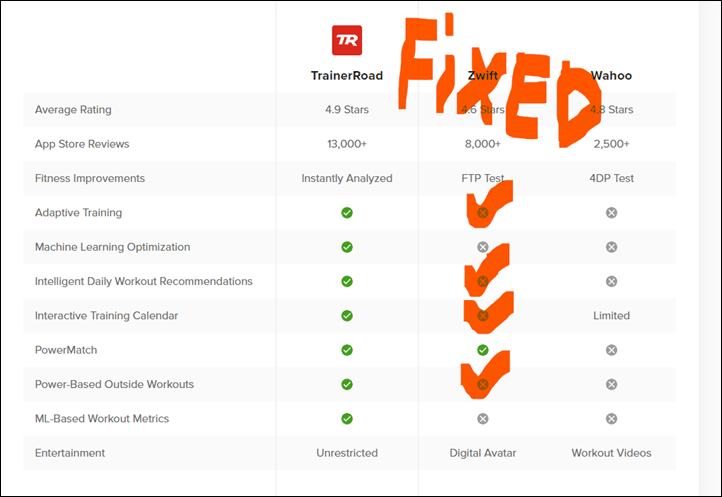If one were reading the tea leaves of the indoor trainer industry, they’d probably be seeing some pretty interesting things. Over the past three weeks, we’ve seen increasingly clear signs that something substantial is about to occur between the two major players of the endurance sports indoor training world: Zwift and TrainerRoad. And, the wheels seem to be in motion already.
First though, as a historical tidbit it’s worth noting that by and large, TrainerRoad and Zwift grew up together. Except, just on different sides of the tracks. One has been heavily funded by investors, while the other has been entirely self-funded. In the beginning, they rarely, if ever acknowledged each other’s existence. And it’s only been in the last few years that we’ve seen more acknowledgment from TrainerRoad that Zwift exists, as the company has seen more and more of its users leverage TrainerRoad’s training, to ultimately compete on Zwift. But for the most part, Zwift has ignored TrainerRoad, instead, offering a relatively basic structured training platform. Despite their differences, many users actually use both platforms (including myself), as a way of keeping themselves occupied indoors.
TrainerRoad started in 2011, where I met them at Interbike – with co-founders Nate Pearson and Reid Weber. Reid eventually went on to join and revamp The SufferFest, which in turn is now owned by Wahoo Fitness. Whereas Nate continues on as CEO of TrainerRoad. Meanwhile, Zwift started in 2014, where I met co-founders Eric Min and Jon Mayfield in a literal coat closet at Eurobike.
From there, these two grew over the years. At first, TrainerRoad likely had a higher subscriber base (especially since it was there three years prior), but over time, Zwift would eclipse it. While neither company wants to give out paid subscriber numbers, the ballparks are likely in the 700-950K subscribers for Zwift, and probably in the 150-350K range for TrainerRoad. Neither are the biggest platforms in the indoor cycling space, but they are titans in name for many outdoor cyclists.
The Three Reasons:
There are three core signs that point towards either an outright acquisition or a significant partnership. Let’s dive through all of them – in the order they occurred.
First up, was the CEO of Zwift, Eric Min, going to Reno, NV on January 12th. In fact, he then published a photo of it on his Facebook & Instagram feed:
View this post on Instagram
Now, while Reno is a lovely slab of concrete with rundown casinos in the middle of the desert, there’s precisely zero reasons to go there in the middle of January. Nearby Lake Tahoe, or skiing at Mt. Rose? Sure, great spots. But downtown Reno? Not so much. After all, Interbike breathed its last breath there 4 years ago.
About this point, you’re probably wondering what else is in Reno, NV? Aside from the National Automobile Museum, there’s also TrainerRoad’s HQ. Now, we won’t hold it against TrainerRoad that they list Reno as their address. After all, I’ve gone on a number of rides with the TrainerRoad crew over the years into the surrounding mountains and landscape. It’s stunning, and would easily be on my very short list of places I could consider moving to, from Amsterdam (within the Top 3, as long as I could avoid having ‘Reno’ on my street address).
But, for Eric, a guy who lives in London – it’s peculiar to fly to Reno. And I certainly didn’t see any epic outside ride photos posted. Sure, he was seemingly at Zwift HQ in Long Beach, CA prior to that. But there are countless nicer places from LGB to take an hour flight than RNO in January.
The next day after visiting, Zwift widely publishes a user survey that uses very TrainerRoad specific language.
The survey asked whether or not folks would be interested in the concept of “Zwift Premium”, which would include a slate of features that are more structured training focused. All of which would cost more (and the exact prices varied, and were part of the survey’s purpose).
Of course, Zwift Premium is literally TrainerRoad – even using the same wording/terms, for example:
1) “Adaptive Training Calendar”: Yup, that’s the exact wording that TrainerRoad uses for their automatically adjusting calendar.
2) “Adaptive Training Plans”: Also, the exact same wording. Now’s a good time to point out that virtually nobody else in the industry uses the term “Adaptive Training Plans”…except TrainerRoad
3) “Daily AI-powered recommendations”: This is TrainerRoad’s “TrainNow” feature, with virtually identical verbiage – even including the “Make you faster” wording that TrainerRoad often uses.
4) Automatic threshold (FTP) detection: While Zwift does do automatic FTP detection, the key wording here is “past performances”, which Zwift doesn’t do. Instead, they only do it upon something new occurring and it’s fairly basic.
5) “Take your workout Outdoors”: This is again, virtually identical wording to TrainerRoad’s feature for “Outdoor workouts”, which also specifically include just Garmin and Wahoo at this time. Zwift has zero outside features these days.
I mean, basically, someone read the homepage of TrainerRoad, where they have this nifty chart, and then put it into the survey:
Ok, so at this point, Eric goes to Reno, presumably meets with TrainerRoad (neither company will say), and then based on that, they decide to press ‘Go’ on a survey to begin some top-level trolling. I mean, research.
But we’re not done here folks. Yesterday, Eric joined the Strava Club for TrainerRoad:
Now, as you can see, Eric is not a connoisseur of numerous Strava Clubs. A third of the ones he’s joined are Zwift variants, another third are existing industry partnerships (Rapha, GCN, Le Col), and then the rest are more local Strava Clubs (such as the Splunk SLAM’s – which is a local club in the Connecticut/NY area). TrainerRoad is the only one he doesn’t have a clear and obvious existing connection to.
But wait, did I mention Zwift CEO Eric Min also now follows TrainerRoad CEO Nate Pearson?
Eric does not follow any other competitors on Strava, nor really that many people at all – just 43 in total, most of which appear to be real-world friends and a few Zwift people. Albeit, I don’t know when his Nate stalking might have started. Nor has Nate reciprocated this following. Though, Nate’s probably still asleep or polishing his air fryer as I write this, so, that’s fair.
Is It Good For Users?

The answer: It’s complicated.
A merger would likely be good for existing consumers of both TrainerRoad and Zwift, in a number of ways:
First, financially for our wallets, it’d undoubtedly be cheaper to use both platforms together, even if Zwift created a premium tier of sorts. Certainly, that premium tier is likely to cost less than paying for standalone products today. It’s unlikely we’ll see pricing increases here for a single product. I think more broadly speaking, we’ll see training platforms increase their prices over the next 1-2 years, as growth slows/flatlines post-COVID-surge.
Second, from a Zwift user’s standpoint, you’d get access to one of the best training-focused platforms in the space. Whether that’s in the form of an integrated product into Zwift, or, just access to TrainerRoad as a standalone app. Given Zwift’s super-limited training functionality today (in terms of tracking historical progress, setting forward goals, having workouts adjust automatically, etc…), everything TrainerRoad has is better than Zwift in this area.
Third, from a TrainerRoad user standpoint, we’d likely see more plans and more clear focus on indoor racing. And, undoubtedly, we’d see them given more money to do more things. It could be moving faster on app initiatives, greater coaching options, more plans, etc… TrainerRoad has historically run a rather lean shop (in terms of finances and headcount bloat), so it’s likely we’d see them have a bit more freedom to move faster within their app.
Fourth, I’d be optimistic that we’d see some of TrainerRoad’s technical chops and standards-following aspects rub off on Zwift. While Zwift makes pretty games, they aren’t known for easily working with the rest of the smart trainer industry, or following standards. They generally prefer to re-invent their own. Whereas TrainerRoad is usually more on ‘Team Industry’ than not. And for the most part, having companies not just follow but also push forward standards is good for consumers.
Fifth, this would give Zwift users credit for outside: Undoubtedly, Zwift is seeing their growth flatline (like other trainer platforms), as people are no longer restricted to indoor locales, and there’s a strong desire to go outside. If we look at concurrent users, even despite the first massive US East Coast snowstorm this weekend, we didn’t see Zwift come close to breaking any of their all-time records from a year ago (set in January). If they were growing, they’d have broken those records at some point this month, and it simply hasn’t happened. Going outside and focusing on outside rides will likely be a huge part of 2022 for many cyclists, finding a way to capitalize on that and ensure users stay with the platform as the weather warms is important to retaining subscribers and growing.

So who’s likely to lose out? Well, everyone else.
Anytime you take two dominant players in the industry, everyone else loses out. It doesn’t matter whether you’re an indoor trainer company or an airline. And the losers are both their competitors, but usually also their competitor’s consumers. There’s immediately less competition, and typically that also means less innovation. Sometimes it can also impact pricing, as well as 3rd party partnerships.
Still, there is solid competition out there remaining. So this isn’t creating a vacuum situation. On the TrainerRoad-like front, you have Xert. Obviously far smaller, but doing relatively similar things in responsive training for many years as well. And on the Zwift side, you’ve got RGT, Rouvy, and Bkool as the most similar in terms of virtual-world like racing and training. And beyond that of course you have Wahoo SYSTM, Kinomap, Tacx Training, and FulGaz (all of which are outlined here).
There’s also the strong likelihood that if Zwift and TrainerRoad were to merge, we’d probably see some additional investor-backed mergers and dev surges to try and counter that. I’d argue that while a TrainerRoad/Zwift merger is probably bad for the industry at large (but good for their own consumers), whereas a merger from some of the other smaller players would be good for both consumers and the industry, as it’d likely strengthen their positions and reduce what is currently a fair bit of duplication (some of it mediocre).

Now, at this point, you’re probably saying: Couldn’t Zwift could just do a TrainerRoad partnership instead? And certainly – that’s absolutely plausible. Zwift has licensed a handful of things in the past. And TrainerRoad’s CEO has said in the past he would be open to a licensing model for their technologies.
But based on years of knowing the CEO’s of both companies, my gut says a buy-out is more likely.
I’m also hesitant to think that Eric would fly to Reno, meet with TrainerRoad face to face, release a big survey to their userbase, then he’d follow TrainerRoad on Strava, then follow the TrainerRoad’s CEO on Strava…all while TrainerRoad, a company known for engaging on rumors in their own forums, have gone completely silent….all for “just” partnership?
Seems unlikely, especially with half a billion dollars floating around Zwift’s bank accounts. But hey – stranger things have happened.
With that – thanks for reading! I’m sure this won’t be the last chapter in this saga.



![clip_image001[7] clip_image001[7]](https://media.dcrainmaker.com/images/2022/01/clip_image0017_thumb-2.png)



0 Commentaires